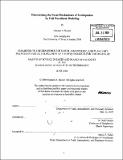| dc.contributor.advisor | M. Nafĭ Toksöz. | en_US |
| dc.contributor.author | Busfar, Hussam A. (Hussam Abdullah) | en_US |
| dc.contributor.other | Massachusetts Institute of Technology. Dept. of Earth, Atmospheric, and Planetary Sciences. | en_US |
| dc.date.accessioned | 2010-03-25T15:01:42Z | |
| dc.date.available | 2010-03-25T15:01:42Z | |
| dc.date.copyright | 2009 | en_US |
| dc.date.issued | 2009 | en_US |
| dc.identifier.uri | http://hdl.handle.net/1721.1/53105 | |
| dc.description | Thesis (S.M.)--Massachusetts Institute of Technology, Dept. of Earth, Atmospheric, and Planetary Sciences, 2009. | en_US |
| dc.description | Includes bibliographical references (leaves 76-78). | en_US |
| dc.description.abstract | Determining the focal mechanism of an earthquake helps us to better characterize reservoirs, define faults, and understand the stress and strain regime. The objective of this thesis is to find the focal mechanism and depth of earthquakes. This objective is met using a full waveform modeling method in which we generate synthetic seismograms using a discrete wavenumber code to match the observed seismograms. We first calculate Green's functions given an initial estimate of the earthquake's hypocenter, the locations of the seismic recording stations, and the velocity model of the region for a series of depths with intervals of 1 km. Then, we calculate the moment tensor for 6840 different combinations of strikes, dips, and rakes for each of those depths. These are convolved with Green's function and with an assumed smooth ramp source time function to produce the different synthetic seismograms corresponding to the different strikes, dips, rakes, and depths. | en_US |
| dc.description.abstract | We use a grid search in order to find the synthetic seismogram, with the combination of depth, strike, dip, and rake, that best fits the observed seismogram. These parameters will be the focal mechanism solution of an earthquake. The whole procedure is repeated for a reduced number of recording stations in order to determine a minimum number of recording stations that is needed for a reliable source mechanism and depth solution. We tested the method using two earthquakes in Southern California. Their locations, depths, and source mechanisms were determined using data from a multitude of stations. Southern California Seismic Network's real-time solution of earthquake 9718013 puts the earthquake at a depth of 15.22 km. The moment tensor inversion method determines the depth of the earthquake to be 8 km with a strike, dip, and rake of 318, 33, -180, respectively. The same network determines the depth of earthquake 14408052 to be 7.3 km. | en_US |
| dc.description.abstract | The moment tensor solution determines the strike, dip, rake, and depth of earthquake 14408052 to be 162, 82, -167, and 5 km, respectively. In this study, we wanted to test our method using seismograms from a relatively few stations. We used five stations for each earthquake, then 3 stations for earthquake 9718013, and two stations for earthquake 14408052. When using five recording stations, the strike, dip, rake, and depth of earthquake 9718013 are 300, 60, -170, and 15 km, respectively. When using three recording stations for the same earthquake, the strike, dip, rake, and depth are 300, 60, -180, and 14 km, respectively. For earthquake 14408052, the strike, dip, rake, and depth are 160, 80, -170, and 7 km, respectively, when using five recording stations. The strike, dip, rake, and depth for this same earthquake are 160, 80, -160, and 8 km, respectively, when using only two stations. | en_US |
| dc.description.abstract | The results show that the ten best solutions for each earthquake are very similar, and identical in many cases, indicating that the method is robust and the solution is unique. This assures us that the full waveform modeling method is a fast and reliable way to find the focal mechanisms and depths of earthquakes using seismograms from a few stations when the velocity structure is known. | en_US |
| dc.description.statementofresponsibility | by Hussam A. Busfar. | en_US |
| dc.format.extent | 78 leaves | en_US |
| dc.language.iso | eng | en_US |
| dc.publisher | Massachusetts Institute of Technology | en_US |
| dc.rights | M.I.T. theses are protected by
copyright. They may be viewed from this source for any purpose, but
reproduction or distribution in any format is prohibited without written
permission. See provided URL for inquiries about permission. | en_US |
| dc.rights.uri | http://dspace.mit.edu/handle/1721.1/7582 | en_US |
| dc.subject | Earth, Atmospheric, and Planetary Sciences. | en_US |
| dc.title | Determining the focal mechanisms of earthquakes by full waveform modeling | en_US |
| dc.type | Thesis | en_US |
| dc.description.degree | S.M. | en_US |
| dc.contributor.department | Massachusetts Institute of Technology. Department of Earth, Atmospheric, and Planetary Sciences | |
| dc.identifier.oclc | 502999814 | en_US |
